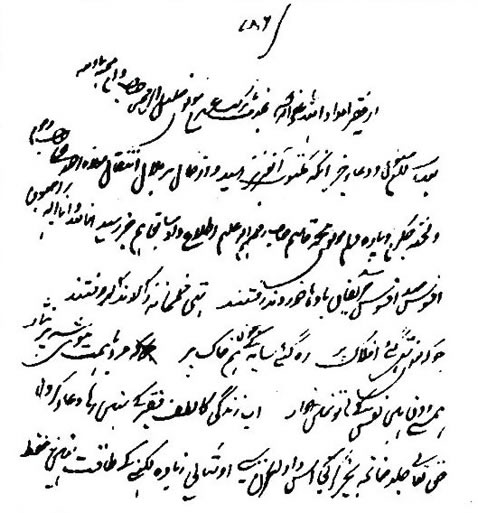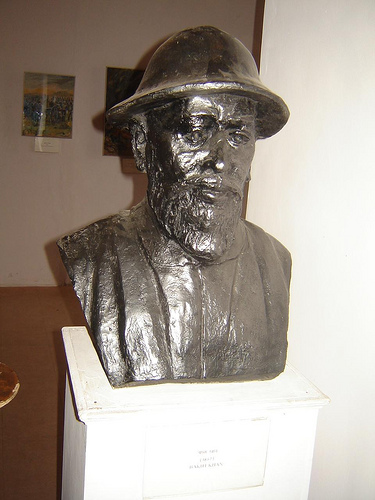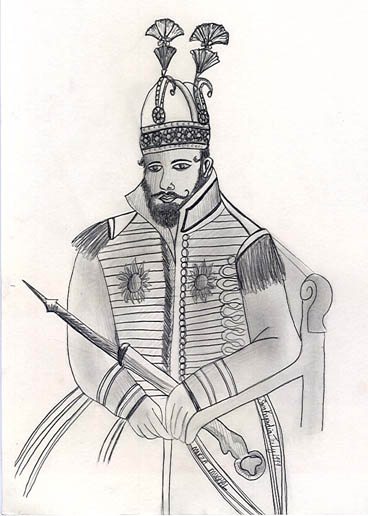<Back to Index>
- Ulama and Revolutionary Haji Imdadullah Muhaajir Makki, 1817
- Commander of the Indian Forces Bakht Khan Rohilla, 1797
- Mughal Prince Mirza Mughal, 1817
PAGE SPONSOR

Haji Imdadullah Muhajir Makki (December 31, 1817 – October 18, 1899) was a South Asian Muslim ulama and a saint in Chishti Sufism.
Haji Imdadullah Muhaajir Makki was born in Nanauta, a town in the district of Saharanpur in Uttar Pradesh, India, on December 31, 1817. His name, "Imdadullah", means "Assistance of Allah". He was a Faruqi or a descendant of 'Umar Faruq. He had three brothers; Zulfiqar and Fida Husain were older than he was, while Bahadur Ali Shah was younger. He also had a younger sister, Bi Wazirun Nisa. When he was born, he was named "Imdad Husain". However, when the muhaddith Shah Muhammad Ishaq heard this name, he disliked it and advised that it be changed to "Imdadullah". He also attributed the names "Khuda Baksh" and "'Abdul Karim" to himself. At the age of three, he was sent to Sayyid Ahmad Shahid, who bestowed upon him the blessing of tabarruk.
When
Imdadullah was seven years old, his mother, Bibi Haseeni, died. She
left behind a will that stated: "Honor this will of mine; no one should
touch my child". The will was strictly observed, and Imdadullah's
education did not receive much attention. However, he yearned to
memorize the Qur’an,
and he did so without outside encouragement, completing the task at the
age of twenty - three. At the age of nine, he accompanied Moulana Mamluk
'Ali to Delhi. There, he studied the syntax and grammar of Arabic, along with Persian. He then studied Mishkatul Masabih under Moulana Muhammad Qalandar Muhaddith Jalalabadi and 'Hisnul 'Hasin and Fiqh Al Akbar under Moulana Abdur Rahim Nanautvi. He also studied Rumi's poem Mathnawi-i Ma’nawi under Shah Abdur Razzaq. These studies were the only education that he received.
At the age of eighteen, his bay'at was accepted by Shaikh Moulana Nasiruddin Naqshbandi, from whom he learned the various adhkar of the Naqshbandi spiritual lineage. After only a few days with his teacher, he was given the mantle of khilafah. Thereafter, he claimed he saw the Prophet Muhammad in a dream. It was on the basis of this dream that he sought for Mianji to accept his bay'at, which Mianji did. After only a few days, the mantle of khilafah was conferred on him once again. After the death of Mianji, Imadadullah became reclusive, developing a fear and detestation of people. He withdrew himself from the midst of people and wandered in the wilderness of Punjab. He would refrain from eating for up to eight days.
After wandering in the wilderness for six months, in 1260 AH, Imadadullah claimed he saw again Muhammad in a dream. In this dream, Muhammad allegedly said: "Come to us". Thus, he was overcome by a strong urge to travel to Medina. On December 7, 1845, he arrived at Bandares. From there, he departed for Arafaat. When he reached Mecca, he had much difficulty. For nine days, he had no food at all. He only lived on Zamzam water. He became extremely weak. On the tenth day, he requested help, but no one assisted him, until one person gave him 100 riyals. From that month on, every month of his life, he would receive 100 riyals. He was never again in need of money.
After the completion of his hajj, Imadadullah remained with Shah Ishaq Muhajir Makki and others, deriving spiritual benefit from them. Shah informed him that, after his pilgrimage to Medina, he should return to India. Sayyid Qudratullah Banarasi Makki sent several of his murids to accompany him to Medina. After visiting Muhammad's grave, he derived the faidh of Medina. While in Medina, he expressed his desire to remain there to Shah Ghulam Murtaza Jhanjhaanwi Madani, who advised him to be patient for a while. After a few days, he returned to Mecca, where he remained for a few days before returning to India.
After Imadadullah's return to India, people started to insist that he accept their bay'at, but he humbly refused. He only began accepting these petitions when he became convinced that it was God's will. Even as he went through the process of bay'at, his yearning to immigrate increased daily. Then, the Mutiny of 1857 occurred. In the aftermath of this upheaval, he bid farewell forever to India. He left via Punjab, visiting the graves of the saints in Hyderabad en route. Thereafter, he embarked from Karachi for Mecca. Imdadullah remained at the ribat of Seth Isma'il on Mount Safa for some time. He passed most of his time in solitude and muraaqabah (meditation) and did not associate much with the inhabitants of Mecca. However, during the hajj, he would remain in public, complying with the wishes of devotees from India to meet him.
Believing that the sunnah obligated him to marry, Imadadullah wed Bi Khadija on February 6, 1866. In 1294 AH, his attendants, after considerable insistence, purchased a house in Haarratul Bab for them.
Imadadullah was of frail physical stature because of mujaahadaat, riyaadhaat,
and lack of food and sleep. In his last years, his body deteriorated to
such an extent that, towards his death, it became difficult for him to
even turn onto his side. He died at the time of Fajr Adhan on Wednesday,
October 18, 1899 at the age of eighty-one. He is buried in Jannatul
Ma'laa in Mecca. He left behind a stick, two sets of winter clothes, and
two sets of summer clothes. In his lifetime he received the bay'at of approximately 500 ulama.

Bakht Khan Rohilla (1797 – 1859) was nominal commander - in - chief of Indian rebel forces in the Indian Rebellion of 1857 against the East India Company.
Bakht Khan was a Pashtun related to the family of Rohilla chief Najib - ul - Daula, from a branch of the Yusufzai tribe. He was born in Bijnor in Rohilkhand and later became a subedar in the army of the East India Company, gaining forty years of experience in the Bengal horse artillery and seeing action in the First Anglo - Afghan War.
When sepoys in Meerut revolted against the British in May 1857, Bakht Khan organized, trained and built up the Rohilla sepoys and then left for Delhi.
By the time Khan arrived at Delhi on July 1, 1857, the city had already been taken by rebel forces and the Mughal ruler Bahadur Shah II had been proclaimed Emperor of India. The emperor's eldest son, Mirza Mughal, also called Mirza Zahiruddin, had been given the title of chief general, but this prince had no military experience. This was the time when Bakht Khan along with his forces arrived in Delhi on Wednesday 1 July 1857. With his arrival the leadership position did improve. Bakht Khan's superior abilities quickly became evident, and the emperor gave him actual authority and the title of Saheb - I - Alam Bhadur, or Lord Governor General. Khan was virtual commander of the sepoy forces, although Mirza Zahiruudin was still the commander in chief.
Bakht Khan faced many problems which needed his immediate attention. The first and foremost problem was financial, to solve which he obtained from the Emperor authority to collect taxes. The second problem was the logistical one of supplies, which became more and more acute with the passage of time and even more so when British forces assaulted the city in September. The British had many spies and agents in the city and were constantly pressurizing Bahadur Shah to surrender. The situation around Delhi proceeded to deteriorate rapidly; Bakht Khan's leadership could not compensate for the rebels' lack of organization, supplies and strength on the part of their monarch. Delhi was besieged on June 8. On September 14 the British assaulted the Kashmiri Gate and Badur Shah fled to Humayun's Tomb before surrendering to the British, against Bakht Khan's pleas, on September 20, 1857.
Bakht Khan himself fled Delhi and joined rebel forces in Lucknow and Shahjahanpur. In 1859 he was mortally wounded and died (He is buried in the Graveyard of Nanser, now in Pakistan, called Koz Band).

HH Prince Mirza Mughal (1817 – 1857) was an Imperial Prince of the Royal Family of India; the fifth son of Emperor Bahadur Shah Zafar, the 12th and last Mughal emperor. His mother, Sharif - ul - Mahal Sayyidini, came from an Aristocratic Sayyid family that claimed descent from Prophet Muhammad.
Following the death in 1856 of his elder brother Mirza Fakhru, Mirza Mughal became the eldest surviving legitimately born son of Bahadur Shah Zafar. However, the British refused to recognize anybody as heir to the throne of Delhi, and indicated that the monarchy would be abolished following Zafar's death.
In
May 1857, sepoys of the British Indian army rebelled against their
British officers and streamed into Delhi. A few days later, Mirza Mughal
and some of his half - brothers petitioned their father to be appointed
in charge of the rebel troops. Their plea was initially refused but
later granted, and Mirza Mughal was designated commander - in - chief.
Mirza
Mughal had no training or experience for his new office; however, he
energetically sought to organize the troops, make arrangements for their
billeting and provisioning, and bring a semblance of order to the edgy
city. His inexperience soon became apparent, and he was upstaged a few
week later by the arrival, at the head of a large force from Bareilly,
of Bakht Khan, a former officer in the British army, who had earned a
fine reputation during the Afghan wars. Shortly after his arrival, the
emperor appointed Bakht Khan commander - in - chief and left Mirza Mughal in
charge of supplies. A few weeks later, following another reshuffle of
offices, Mirza Mughal was given charge of administering the city of
Delhi.
Following the failure of the Indian Rebellion of 1857, the last Mughal Emperor, Bahadur Shah II, was captured by Major Hodson at his camp at Humayun’s Tomb, just outside Delhi. Mirza Mughal and two other Mughal princes were with the Emperor (another son, Mirza Khizr Sultan, and a grandson, Mirza Abu Bakr) and they refused to surrender. The next day, Hodson went back to the camp with one hundred horsemen and demanded the three princes' unconditional surrender. A crowd of thousands of rebels gathered, and Hodson ordered them to disarm, which they did. He sent the princes ahead with an escort of ten men, while with his remaining ninety men he collected the arms of the crowd.
On going after the princes, Hodson found the crowd was again pressing towards the escort. The princes were mounted on a bullock cart and driven towards the city. As they approached the city gate, Hodson ordered the three princes to get off the cart and to strip naked. He then shot them dead, before stripping the princes of their signet rings, turquoise arm bands and bejeweled swords. Their bodies were thrown in front of a kotwali, or police station, and left there to be seen by all. The gate near which the executions were performed is called the Khooni Darwaza, or Bloody Gate.